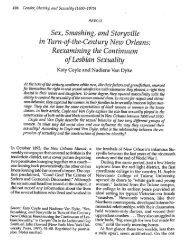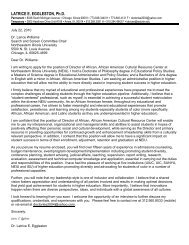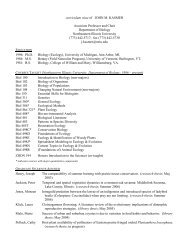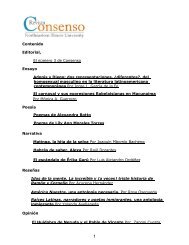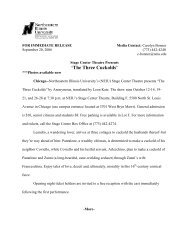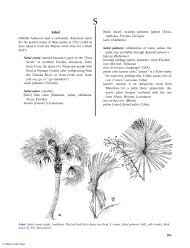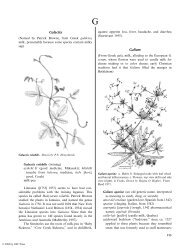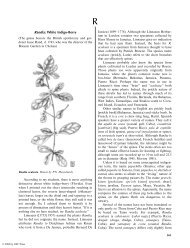Herba Cana - Northeastern Illinois University
Herba Cana - Northeastern Illinois University
Herba Cana - Northeastern Illinois University
Create successful ePaper yourself
Turn your PDF publications into a flip-book with our unique Google optimized e-Paper software.
© 2004 by CRC Press<br />
The Ethnobotany 545<br />
man (1998) listed only the Comanche as using the<br />
fruits as food, both fresh and dried. Yanovsky (1936)<br />
and Hudson (1976) wrote that all southeastern tribes<br />
ate plums of all kinds.<br />
Prunus americana ranges from Florida to northern<br />
Arizona and New Mexico, north to Utah and Wyoming,<br />
and east through Iowa, Indiana, Wisconsin,<br />
Minnesota, New York, southern Ontario, Saskatchewan,<br />
and Manitoba (Fernald 1950, Kearney and<br />
Peebles 1951). Little (1979) said the American plum<br />
grows in the mountains of northern Mexico, but that<br />
appears to be a confusion with P. mexicana (Standley<br />
1920 /1926).<br />
Fruits of P. americana were used as food by at least<br />
the Apache, Cherokee, Cheyenne, Creeks, Crow,<br />
Dakota, Iroquois, Isleta, Kiowa, Meskwaki, Ojibwa,<br />
Omaha, Osage, Pawnee, Ponca, and Winnebago<br />
(Gilmore 1919, Hunter [1823] 1973, Densmore 1928,<br />
Yanovsky 1936, Sturtevant 1955, Moerman 1998).<br />
Bundles of the flexible twigs were used as brooms<br />
throughout the Missouri River region, and the Omaha<br />
planted their beans, corn, and squash when kande<br />
came into bloom (Gilmore 1919). Isleta, Navajo, and<br />
Ojibwa made dyes from the bark, producing yellow or<br />
red, depending on the other plants mixed and<br />
mordants (Moerman 1998).<br />
Several tribes used P. americana in medicine<br />
(Moerman 1998). The Cherokee made a cough syrup<br />
of the bark, and an infusion for kidney and bladder<br />
problems (Hamel and Chiltoskey 1975). The Cheyenne<br />
applied the mashed fruits to mouth diseases, and<br />
the Meskwaki used the root bark. The Mohegan made<br />
an infusion of twigs to treat asthma. The Omaha<br />
boiled root bark and applied it to skin abrasions<br />
(Gilmore 1919). The Ojibwa made a decoction of the<br />
roots for intestinal worms and put a decoction of the<br />
bark on cuts and wounds as a disinfectant (Densmore<br />
1928); they also used the rootlets in a remedy for<br />
diarrhea. The Rappahannock used the red plum in an<br />
undisclosed medicine.<br />
The last southeastern plum to be named was P.<br />
geniculata. Roland M. Harper (1878 /1966) described<br />
that species from Lake County in 1911, and it is so<br />
rare that it has been considered federally endangered<br />
since 1987 (Ward 1979, Coile 2000, Chafin 2001).<br />
Little (1979) did not even discuss the name. This small<br />
plum has fruits to about 2 cm wide and grows in the<br />
heart of what was Timucua territory before the arrival<br />
of the Europeans.<br />
Moerman (1998) does not list P. myrtifolia as used<br />
by native people, and with its limited distribution in<br />
Miami-Dade County, that is not surprising. Like other<br />
species in the genus, this one contains hydrocyanic<br />
glycosides. Bark, leaves, and twigs are used fresh for<br />
asthma and cough in Cuba (Roig 1945). In Hispaniola<br />
and Puerto Rico the trunks are used for electric line<br />
posts, in rural construction, and in cabinetwork<br />
(Liogier 1974, Little et al. 1974). The bark has a<br />
strong smell of almonds and is used to clean false teeth<br />
(Liogier 1974).<br />
Stephen Elliott named P. umbellata, called the<br />
‘‘sloe of the South’’ because of its black fruits. At the<br />
time he named the plum, Elliott (1821) recorded that<br />
people were using the fruits in preserves. When they<br />
are available, they are preferred because they are<br />
unusually rich in pectin (Harrar and Harrar 1946). I<br />
found no records that they were used as a substitute<br />
for the European sloe (P. spinosa), but it would be a<br />
safe bet that they were.<br />
The laurel-cherry (P. caroliniana) has the second<br />
most restricted range of the species, growing on the<br />
coastal plain from southeastern North Carolina to<br />
central Florida, west to eastern Texas (Little 1979;<br />
Diggs et al. 1999). Alabama people boiled the inner<br />
bark to make a red dye used to color split cane woven<br />
into baskets. Porcher (1863) was enthusiastic about<br />
these plants during the Civil War but largely as an<br />
ornamental. He wrote: ‘‘This tree, the flowers of which<br />
are much frequented by bees, grows abundantly on the<br />
sea-coast of our states, and is certainly one of the most<br />
beautiful and manageable evergreens that we possess.<br />
It can be cut into any shape, and is of a most attractive<br />
green color. It forms an impervious hedge, and grows<br />
rapidly.’’ About its potential as medicine, Porcher<br />
continued: ‘‘The black, oval berries contain an abundance<br />
of Prussic acid, as does the whole tree; but I do<br />
not know of any use to which it is applied. Dr.<br />
Thompson has found great use from Prussic acid,<br />
largely diluted, as a local application in impetigo.’’<br />
Hocking (1997) added that the leaves and bark<br />
contain prulaurasin, which hydrolyzes to racemic<br />
mandelonitrile and glucose and releases hydrogen<br />
cyanide. As with all members of the genus, laurelcherry<br />
may be fatal to stock if browsed in quantity<br />
(Harrar and Harrar 1946).<br />
Wild black-cherry (P. serotina) grows from Florida<br />
to Texas and southern Arizona, south through Mexico<br />
(Baja California Sur, Sonora east to Tamaulipas,<br />
south to Oaxaca and Chiapas), Guatemala, and north<br />
to North Dakota and Minnesota, Nova Scotia, New<br />
Brunswick, southern Quebec, and southern Ontario<br />
(Fernald 1950, Little 1979). The Mexican and tropical<br />
American plants are usually segregated into P. serotina<br />
ssp. capuli (Felger et al. 2001), formerly recognized<br />
as a distinct species. Fruits from this subspecies<br />
have long been made into alcoholic and non-alcoholic<br />
drinks, and they are eaten fresh and preserved<br />
throughout the Americas (Felger et al. 2001).<br />
The cherry now called ssp. capuli was first noted in<br />
Mexico by Hernándo Cortez’s men in 1519 when the





